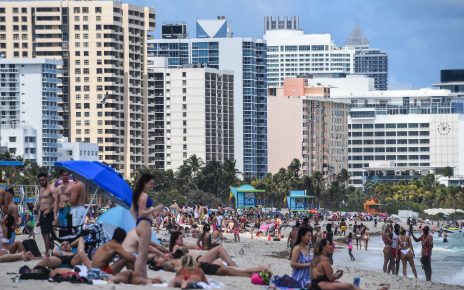Uncertainty about the future seems to be the one sure thing in the coronavirus pandemic. No one knows if COVID-19 will persist at its current pace or if recent increased interactions among people will spawn an onslaught of smaller outbreaks or a larger second wave. But a few things are clear: The virus that causes the disease is likely to continue circulating through the population until there is a vaccine. And flu season is only a few months away.
The overlap of COVID-19 and influenza has epidemiologists and some policy makers concerned. The U.S. may soon face two epidemics at the same time, they worry, and this combination could precipitate a crisis unlike any other. “The worst-case scenario is both [the coronavirus and the flu] are spreading fast and causing severe disease, complicating diagnoses and presenting a double burden on the health care system,” says Marc Lipsitch, an epidemiologist at Harvard University. A few states are planning for extra capacity in hospitals to deal with both illnesses.
Yet another, more favorable future also might be possible as these viruses cross paths, Lipsitch and other infectious disease forecasters say. The behavioral changes people have already adopted to flatten the curve of COVID-19—such as social distancing, hand washing, and mask wearing—could lessen the impact of the flu.
“It is hard to predict,” says Sarah Cobey, an epidemiologist at the University of Chicago. Not only is it unknown whether the coronavirus will ebb and flow as seasons change, but “what’s really hard is that I don’t have a good forecast for human behavior and policy decisions that are going to be made over the next couple of months,” she says.
Jeffrey Shaman, an epidemiologist at Columbia University, says if SARS-CoV-2 follows seasonal patterns like some other coronaviruses and influenza viruses do, it could subside in the summer. “But that could come back to haunt us,” he adds. “We might get complacent; we might not be prepared.” Four flu virus pandemics over the past 100 years—H1N1 in 1918, H2N2 in 1957, H3N2 in 1968 and H1N1 in 2009—had a deadly second wave around the fall and early winter. COVID-19 could do the same. “The concern that we might have a double whammy of flu and coronavirus is legitimate,” Shaman says.
[Both indoor and outdoor factors influence how viruses wax and wane with the seasons.]
Every year, influenza sickens millions of people in the U.S. In particularly bad years, flu surges overwhelm hospitals and health care systems. During the 2017–2018 flu season, local news outlets reported that hospitals across the country flew in nurses from other states, erected tents in parking lots and sent incoming ambulances to other facilities because of the overload of patients. The U.S. Centers for Disease Control and Prevention estimates that between 46,000 and 95,000 Americans died from the illness that season.
Though the new coronavirus and influenza viruses can cause some of the same symptoms—such as fever, cough and fatigue—these similarities are mostly superficial. The pathogens use different receptors on cells to gain access to our bodies. As a result, SARS-CoV-2 could enter one way, while a flu virus slips in another. A study of about 1,200 patients, conducted in northern California and published in JAMA in April, found that one in five people who were diagnosed with COVID-19 were coinfected with another respiratory virus. The risk of such coinfections is typically low, says Ben Cowling, an epidemiologist at the University of Hong Kong, but it gets higher when two viruses are circulating heavily in the same region. “It’s possible you could get infected with both at the exact same time—if you’re having a really bad day,” he says.
Cowling and some other epidemiologists think the way viruses interact and interfere with each other could reduce the impact of any coronavirus-influenza collision, however. They have tracked epidemics for decades and have found that outbreaks of respiratory viruses usually do not reach their peaks during the same time period. Though no one knows exactly why, a study published last year in the Proceedings of the National Academy of Sciences USA hypothesized that temporary bursts of immunity to different viruses on the cellular level could shift the course of future epidemics. For example, an outbreak of a rhinovirus—which causes a common cold—appears to have delayed the arrival of the 2009 influenza pandemic in Europe. And that effect, in turn, likely postponed epidemics of another disease: respiratory syncytial virus.
“Right now COVID-19 has a huge fraction of the population susceptible to it,” Cobey says. “Assuming that we’re not incredibly diligent about stopping transmission, it’s going to continue burning through populations, leaving this wake of immunity that might be slightly effective against other viruses.” She admits this idea sits on the “speculative side of hypotheses.” And the theoretical immunity would not be strong enough for, say, someone who has recovered from a coronavirus to shrug off the flu, or vice versa. But on a population level, it could mean that other viruses might not spread as quickly as normal, so their epidemic peaks could be delayed.
Another reason why the collision might not be dramatic has less to do with virology and more to do with human behavior: both COVID-19 and the flu are transmitted, for the most part, by respiratory droplets, so the same prevention strategies used to reduce the spread of the former will also work for the latter.
In a study in the Lancetin April,Cowling showed that the public health measures introduced in Hong Kong to contain the coronavirus—such as border restrictions, quarantine and isolation, social distancing, mask wearing and hand washing—led to a rapid decline in flu activity. In the U.S., new flu cases plummeted a few weeks after COVID-19 was declared a global pandemic. The 2019–2020 flu season, once headed to be among the worst in decades, ended six weeks early.
But as states in the U.S. ease restrictions on activity and travel, people’s behaviors could change in ways that ease virus transmission, so a double threat is still possible. And it is not clear what, if any, federal response is being mounted to prepare for it. In April Robert Redfield, director of the CDC, told the Washington Post that “we’re going to have the flu epidemic and the coronavirus epidemic at the same time.” After President Donald Trump claimed that Redfield was misquoted, the director walked his statement back, saying he did not mean the current crisis would be worse, just “more difficult and potentially complicated.” (The CDC did not respond to Scientific American’s requests for further comment.)
In late May a group of Democratic senators sent a letter to the White House asking it to prepare for the worst overlap scenario. “We urge you to begin planning for and activating the resources of the federal government now,” they wrote, “to increase capacity, supplies, and vaccinations to prevent public health and medical systems from being overwhelmed by simultaneous peaks of both of these deadly infectious diseases in the fall.”
On the state level, some are updating hospital surge plans and expanding infectious disease surveillance programs to include both the flu and COVID-19. North Carolina’s state health director Elizabeth Tilson, who co-chairs the state’s coronavirus task force, has been working with health systems to develop plans for increasing their surge capacity by converting unused facilities, procuring extra beds or hiring extra staff. “Thankfully, we haven’t had to pull the trigger on any of our emergency med surge plans. But we have all those plans in place, whether it be COVID-19 or COVID-19 and flu,” she says.
Cobey has been trying to convince the government of her home state of Illinois to set up a sentinel surveillance plan that could alert officials to coming surges of COVID-19 and flu cases. But she says her suggestions have received little traction. Such surveillance systems already exist in other states, including North Carolina and Michigan. The CDC also tracks both illnesses on the national level and releases a weekly surveillance report on the viruses that cause them.
Tilson points out that whatever happens, there is one basic step people can take that may alter the trajectory of either epidemic. “Look, we don’t have a vaccine for COVID-19,” she says. “We do have a vaccine for flu. Get the vaccine.”
Read more about the coronavirus outbreak from Scientific American here. And read coverage from our international network of magazines here.



